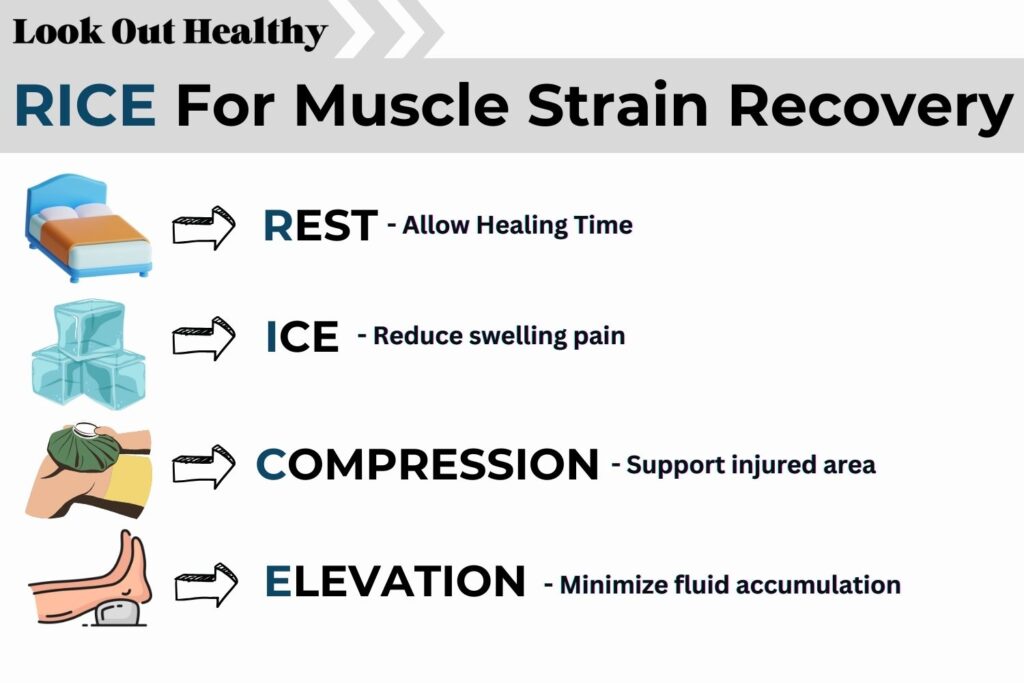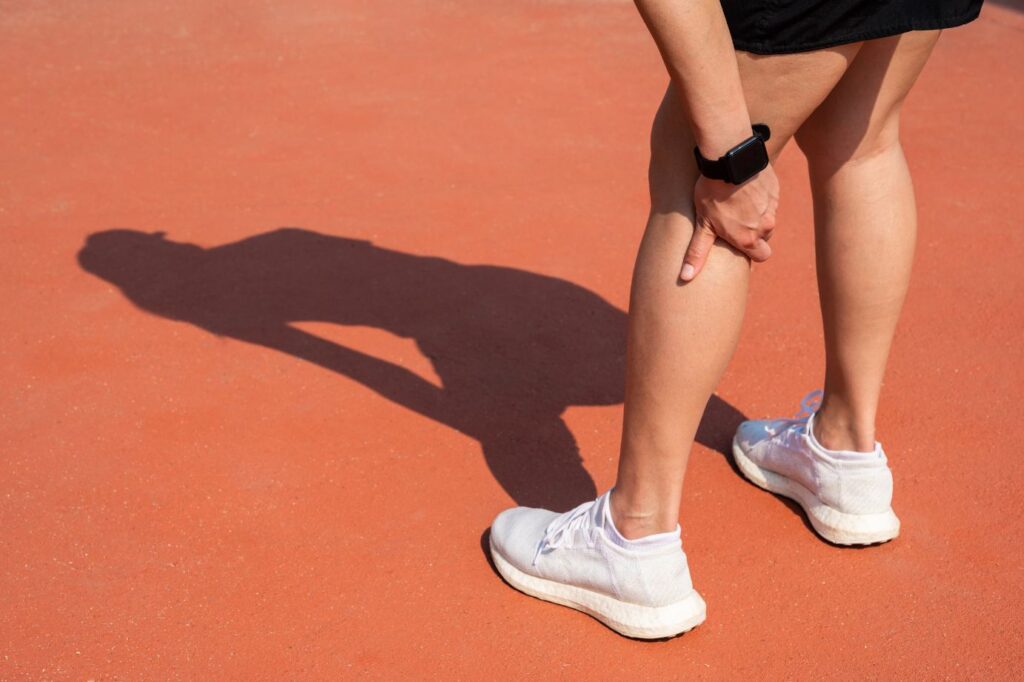- Symptoms of a Muscle Strain
- Causes of Muscle Strains?
- RICE Method for Muscle Strain Recovery
- Additional Tips for Faster Muscle Strain Recovery
- Preventing Muscle Strain Injuries
- Frequently Asked Questions
When you push your body to its limits, you take a risk. This applies to every athlete and fitness enthusiast. However, pushing too hard can result in a muscle strain. Recovery from a muscle strain can be slow and frustrating. Whether you’re a seasoned athlete or someone with an active lifestyle, these painful injuries happen when muscle fibers are stretched too much or torn. Sprains, on the other hand, affect the ligaments around joints.
From minor pulls to severe strains, it’s important to recover properly from a muscle strain. Neglecting to care for a strained muscle can lead to lingering pain, limited movement, and a higher risk of future injuries. This comprehensive guide on how to speed up muscle strain recovery provides practical tips to help athletes and active individuals recover stronger than ever. By following targeted strategies, you can help your body heal naturally, reduce downtime, and get back in the game sooner.
Symptoms of a Muscle Strain
Recognizing the signs of a muscle strain is crucial for proper treatment and recovery. Common symptoms can include:
- Pain: A strained muscle will likely cause immediate, sharp pain that may intensify with movement or stretching.
- Swelling: Inflammation and swelling around the affected area are common, especially with moderate to severe strains.
- Muscle weakness: Depending on the severity, you may experience reduced strength and difficulty moving the muscle.
- Bruising: In some cases, the tearing of muscle fibers can cause bruising and discoloration around the injury site.
Muscle strains are typically graded based on their severity:
- Mild (Grade 1): A small number of muscle fibers are stretched or torn, resulting in mild pain and tenderness.
- Moderate (Grade 2): More significant tearing of muscle fibers, often accompanied by swelling, bruising, and moderate pain that limits movement.
- Severe (Grade 3): A complete or near-complete tear of the muscle, resulting in severe pain, significant swelling and bruising, and an obvious deformity or indentation in the muscle.
Identifying the grade of your muscle strain can help guide the appropriate treatment and recovery approach.
ALSO READ | Signs of Gaining Muscle and Losing Fat
Causes of Muscle Strains?
- Overuse/repetitive motions: Repeating the same movements excessively, straining muscle fibers over time.
- Improper exercise form/techniques: Using incorrect form during exercise or physical activities puts undue stress on muscles.
- Lifting heavy objects with poor body mechanics: Attempting to lift or move heavy objects without proper technique can easily strain muscles.
- Sudden increase in activity level: Abruptly increasing the duration, intensity, or frequency of physical activity without conditioning.
- Tight/inflexible muscles: Muscles that lack flexibility have a limited range of motion and can be overstretched more easily.
- Muscle fatigue: Continuing exercise when muscles are already tired makes them more susceptible to strains.
RICE Method for Muscle Strain Recovery
The RICE method (Rest, Ice, Compression, and Elevation) is a well-established approach for treating muscle strains and promoting faster recovery, commonly needed for strains occurring in the foot, leg, or back.

- REST: Resting the injured muscle is crucial in the early stages of recovery. For mild strains, 2-3 days of rest may be sufficient, while moderate strains may require 5-7 days of rest or until the pain subsides. Severe strains could take several weeks of rest and immobilization. Avoid activities that cause pain or discomfort during this time.
- ICE: Applying ice to the affected area can help reduce swelling, inflammation, and pain. Use an ice pack wrapped in a thin towel, and apply it to the strained muscle for 15-20 minutes every 2-3 hours during the first 48-72 hours. Avoid putting ice directly on the skin to prevent cold injuries.
- COMPRESSION: Gently wrapping the injured area with an elastic bandage can help minimize swelling and provide support to the strained muscle. Ensure the bandage is snug but not too tight, as excessive compression can impair blood flow. Rewrap the bandage if it becomes loose or loses its compressive effect.
- ELEVATION: Keeping the injured muscle elevated above the level of your heart can aid in reducing swelling and inflammation. This position assists with draining excess fluid and promoting healing. When possible, elevate the affected area at least 6 inches above the heart level using pillows or other supportive objects.
Consistently applying the RICE method during the initial stages of a muscle strain can significantly accelerate the recovery process and help manage pain and swelling effectively.
ALSO READ | Calisthenics Workout Plan With Free PDF
Additional Tips for Faster Muscle Strain Recovery
While the RICE method is a cornerstone of initial muscle strain treatment, incorporating additional strategies can further accelerate your recovery:
- Heat Therapy: After the initial inflammation has subsided (typically 48-72 hours), applying heat can promote healing by increasing blood flow to the injured area. This increased blood flow delivers more oxygen and nutrients to the damaged tissues, facilitating repair and reducing muscle spasms. Use a heating pad, warm compress, or take a warm bath/shower to gently relax the muscle and relieve lingering pain.
- Stretching and Strengthening: As the pain subsides, introduce gentle stretching exercises to improve flexibility and range of motion in the affected muscle. This helps prevent the formation of scar tissue and adhesions, which can limit mobility. Light strengthening exercises can also help rebuild the muscle and restore its function. Consult a healthcare professional or physical therapist for personalized exercise recommendations.
- Pain Management: Over-the-counter anti-inflammatory medications like ibuprofen or naproxen can help alleviate pain and reduce swelling associated with muscle strains. Additionally, consider topical pain relievers like menthol or capsaicin creams, which can be applied directly to the affected area for localized relief. Physical therapy techniques like massage, ultrasound, or electrical stimulation may also be recommended by your healthcare provider for pain management and improved healing.
Remember, patience and proper rehabilitation are key to a full recovery. Rushing back into strenuous activities before the muscle has adequately healed can lead to re-injury or chronic problems. Follow your healthcare provider’s guidance and listen to your body’s signals throughout the recovery process.
Preventing Muscle Strain Injuries
While treating muscle strains is important, preventing them in the first place should be the ultimate goal. Here are some key strategies to help reduce your risk of sustaining a muscle strain:
WARM-UP AND COOL-DOWN
- Perform light aerobic exercises and dynamic stretches before activities
- Cool down with static stretches afterward
MAINTAIN PROPER FORM
- Use correct technique during exercise and sports
- Consider working with a trainer/coach
LISTEN TO YOUR BODY
- Avoid pushing too hard, too soon
- Gradually increase intensity/duration
- Rest if you experience pain or excessive fatigue
STAY HYDRATED
- Drink fluids before, during, and after activities
- Hydration aids muscle function and recovery
Following these simple preventive measures can go a long way in reducing your risk of muscle strains and keeping you active and injury-free.
Conclusion
Muscle strains can be frustrating setbacks, but with the proper approach, you can accelerate your recovery and get back to your active lifestyle more quickly. Remember to follow the RICE method (Rest, Ice, Compression, and Elevation) during the initial stages of injury, and incorporate additional strategies like heat therapy, gentle stretching, and over-the-counter pain relievers as your condition improves.
Prevention is also key to avoiding muscle strains in the first place. Always warm up properly, maintain correct form during exercise, listen to your body’s signals, and stay hydrated.
While mild to moderate muscle strains can often be managed at home, it’s crucial to consult a healthcare professional for severe pain, inability to use the affected limb, or if you have concerns about the extent of your injury. They can provide personalized guidance, identify any underlying issues, and recommend appropriate treatment options.
If you found this guide helpful, share it with your friends and fellow fitness enthusiasts to spread awareness about proper muscle strain recovery. And remember, for personalized advice tailored to your specific situation, don't hesitate to consult a healthcare professional.
Frequently Asked Questions (FAQs)
The recovery time can vary depending on the severity of the strain, ranging from a few days for mild strains to several weeks or even months for more severe cases.
It’s generally advisable to rest the affected muscle and avoid activities that cause pain or discomfort until the initial inflammation and pain subside.
Yes, bruising is a common symptom of moderate to severe muscle strains, as the tearing of muscle fibers can cause bleeding and discoloration around the injury site.
Seek medical attention if you experience severe pain, significant swelling or bruising, inability to use the affected limb, or if the pain persists for more than a week without improvement.
While muscle strains can happen even with proper precautions, maintaining flexibility, using correct form during exercise, gradually increasing activity levels, and staying hydrated can help reduce your risk.

